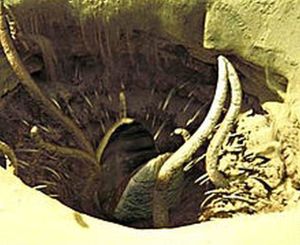An article in the journal Large Unusual Creatures in Asia-Southwest (LUCAS), due out next week, describes the process by which the researchers found and identified the Sarlacc.
 Jedda, December 16 – Zoologists have uncovered the first known specimen on Earth of a legendary galactic creature that embeds itself in the ground and waits for prey to fall in, digesting it over the course of a thousand years.
Jedda, December 16 – Zoologists have uncovered the first known specimen on Earth of a legendary galactic creature that embeds itself in the ground and waits for prey to fall in, digesting it over the course of a thousand years.
Researchers from the University of Pinewood in England surveying desert fauna in remote areas of the Arabian Peninsula came upon the Sarlacc about seventy-five miles (120 kilometers) northwest of Jedda, which sits on the Red Sea, along the country’s west coast. The specimen’s circular maw measures nearly three meters in diameter, making it one of the largest known specimens.
The discovery occurred last month. An article in the journal Large Unusual Creatures in Asia-Southwest (LUCAS), due out next week, describes the process by which the researchers found and identified the Sarlacc. Lead author Bob Afette recounted a number of dramatic moments along the way, including the loss of a camel to the creature, which caught the animal in one of its tentacles and slowly dragged in into its spiked mouth. Some of the team’s important equipment met a similar fate, but the human members made it away unscathed, thanks in part to shots fired by their local Bedouin escort, from a group called the Jedda Knights.
Afette said the immediate origins of the Sarlacc were unclear. “Sarlacci reproduce via spores that they launch into outer space and burrow into the sand at their destination, so we assume this specimen arrived some time ago from beyond the solar system,” he wrote. “But not much is known about the growth rate of the species, so much further study is warranted before we can determine the age of this Sarlacc.”
The article explores, if superficially, some of the implications of the find. “The impact of the Sarlacc on the ecosystem should be minimal,” notes the article. “Rodents, the occasional ruminant, and maybe a scavenging bird are all that would happen to fall into, or be dragged into, its mouth. You can’t expect a sail barge full of gangsters to happen by every week. The vast majority of this specimen’s nourishment will come from the nutrients it absorbs through its extensive root system, which we estimate covers a radius of perhaps seventy meters from the mouth and tentacles.” The biggest question, explained Afette, involves the Sarlacc’s reproductive capacity.
“We don’t know under what circumstances, or in what quantities, it will produce spores, but it is possible they will land elsewhere on Earth,” he said in an interview. “That could pose serious hazards for the planet – there are some massive life-form readings in some places.”
A Saudi government official, speaking on condition of anonymity, said the country might now start accepting refugees from Syria, since there was now somewhere to put them.
Please support our work through Patreon.




